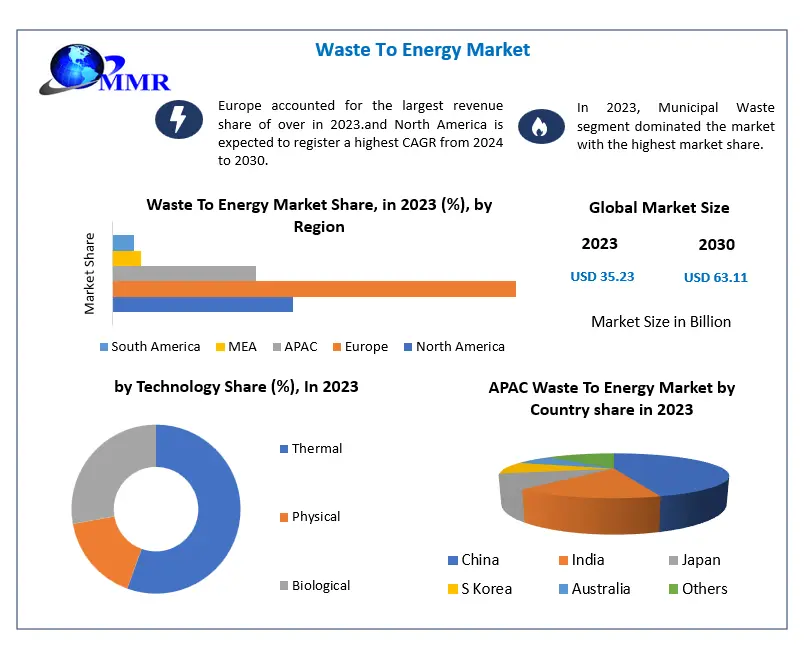Waste to Energy Market Size, Share, and Future Trends (2024-2030)

Waste to Energy Market: Transforming Waste into Sustainable Power
The global Waste to Energy (WtE) Market is emerging as a critical solution to two of the world’s most pressing challenges: waste management and energy generation. As urbanization accelerates and populations grow, the volume of waste generated is reaching unprecedented levels. At the same time, the demand for clean and sustainable energy is intensifying. The Waste to Energy Market bridges these gaps by converting waste materials into usable energy, offering a sustainable alternative to landfills and fossil fuels.
This blog delves into the Waste to Energy Market, exploring its growth drivers, technologies, benefits, challenges, and future outlook. Whether you're an industry professional, an environmental enthusiast, or simply curious about sustainable solutions, this guide will provide valuable insights into how waste is being transformed into energy.
What is the Waste to Energy Market?
The Waste to Energy Market refers to the industry focused on technologies and processes that convert waste materials into electricity, heat, or fuel. This market encompasses a range of methods, including incineration, gasification, pyrolysis, and anaerobic digestion. By harnessing the energy potential of waste, these technologies reduce the reliance on landfills and contribute to a circular economy.
The market is gaining traction globally as governments, businesses, and communities seek sustainable ways to manage waste and meet energy demands. According to recent reports, the Waste to Energy Market is projected to grow at a compound annual growth rate (CAGR) of over 6% from 2023 to 2030, driven by increasing waste generation and supportive regulatory policies.
Key Technologies Driving the Waste to Energy Market
1. Incineration
Incineration is one of the most widely used methods in the Waste to Energy Market. It involves burning waste at high temperatures to produce steam, which drives turbines to generate electricity. Modern incineration plants are equipped with advanced emission control systems to minimize environmental impact.
2. Gasification
Gasification converts organic or fossil-based waste materials into synthetic gas (syngas) through a high-temperature process. Syngas can be used to produce electricity, heat, or biofuels, making it a versatile option in the Waste to Energy Market.
3. Pyrolysis
Pyrolysis involves heating waste in the absence of oxygen to break it down into bio-oil, syngas, and char. This technology is particularly effective for processing plastic waste and biomass, offering a sustainable alternative to traditional disposal methods.
4. Anaerobic Digestion
Anaerobic digestion uses microorganisms to break down organic waste in the absence of oxygen, producing biogas (a mixture of methane and carbon dioxide). Biogas can be used for electricity generation, heating, or as a renewable natural gas.
Benefits of the Waste to Energy Market
The Waste to Energy Market offers numerous environmental, economic, and social benefits:
1. Reduction in Landfill Use
By diverting waste from landfills, WtE technologies help reduce land pollution and greenhouse gas emissions, particularly methane, which is a potent contributor to climate change.
2. Renewable Energy Generation
WtE processes produce renewable energy, reducing dependence on fossil fuels and supporting global efforts to combat climate change.
3. Resource Recovery
Many WtE technologies enable the recovery of valuable resources, such as metals and minerals, from waste streams, promoting a circular economy.
4. Job Creation
The development and operation of WtE facilities create jobs in engineering, construction, and waste management, contributing to economic growth.
More Insights Of Full Report In Details:https://www.maximizemarketresearch.com/market-report/waste-to-energy-market-wte/13394/
Challenges Facing the Waste to Energy Market
Despite its potential, the Waste to Energy Market faces several challenges:
1. High Initial Costs
The capital investment required for WtE facilities can be substantial, posing a barrier to entry for some regions and stakeholders.
2. Public Perception
Concerns about emissions and the environmental impact of incineration have led to opposition from some communities, highlighting the need for transparent communication and stringent regulations.
3. Waste Composition
The efficiency of WtE technologies depends on the composition of the waste feedstock. Contaminated or non-combustible waste can reduce the effectiveness of these processes.
Future Outlook for the Waste to Energy Market
The Waste to Energy Market is poised for significant growth in the coming years, driven by several key trends:
1. Government Policies and Incentives
Many governments are implementing policies to promote WtE technologies, including tax incentives, subsidies, and renewable energy targets.
2. Technological Advancements
Ongoing research and development are leading to more efficient and environmentally friendly WtE technologies, expanding the market’s potential.
3. Rising Waste Generation
With global waste generation expected to increase by 70% by 2050, the demand for sustainable waste management solutions like WtE will continue to grow.
4. Focus on Circular Economy
The shift toward a circular economy, where waste is viewed as a resource, is driving investment in WtE technologies and infrastructure.
Conclusion
The Waste to Energy Market represents a transformative approach to waste management and energy generation. By converting waste into valuable resources, this market addresses critical environmental and economic challenges while supporting the transition to a sustainable future.
As technology advances and awareness grows, the Waste to Energy Market is set to play an increasingly important role in the global energy landscape. Whether through incineration, gasification, or anaerobic digestion, the potential to turn waste into power is immense—and the benefits are undeniable.
By embracing innovative solutions and fostering collaboration between governments, businesses, and communities, we can unlock the full potential of the Waste to Energy Market and create a cleaner, greener world for generations to come.
- Questions and Answers
- Opinion
- Motivational and Inspiring Story
- Technology
- Live and Let live
- Focus
- Geopolitics
- Military-Arms/Equipment
- الحماية
- Economy
- Beasts of Nations
- Machine Tools-The “Mother Industry”
- Art
- Causes
- Crafts
- Dance
- Drinks
- Film/Movie
- Fitness
- Food
- الألعاب
- Gardening
- Health
- الرئيسية
- Literature
- Music
- Networking
- أخرى
- Party
- Religion
- Shopping
- Sports
- Theater
- Health and Wellness
- News
- Culture

